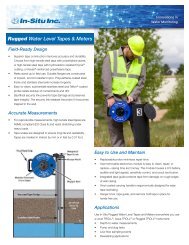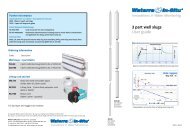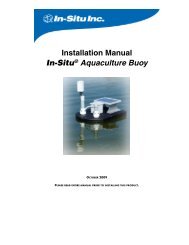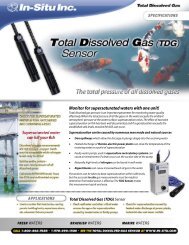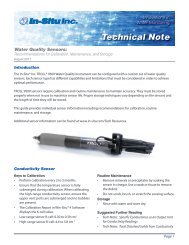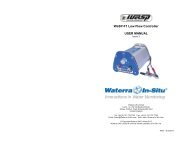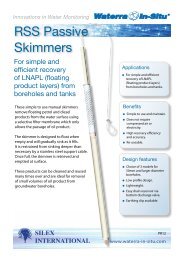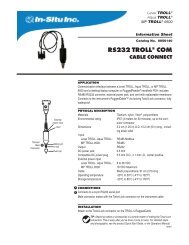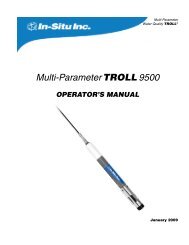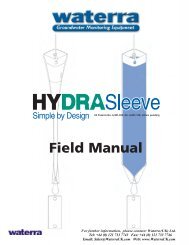Water Level Accuracy and Correcting for Errors due to ... - In-Situ Inc.
Water Level Accuracy and Correcting for Errors due to ... - In-Situ Inc.
Water Level Accuracy and Correcting for Errors due to ... - In-Situ Inc.
You also want an ePaper? Increase the reach of your titles
YUMPU automatically turns print PDFs into web optimized ePapers that Google loves.
Technical Note 001<br />
<strong>Water</strong> <strong>Level</strong> <strong>Accuracy</strong> <strong>and</strong> <strong>Correcting</strong> <strong>for</strong> <strong>Errors</strong><br />
<strong>due</strong> <strong>to</strong> Gravitational Acceleration <strong>and</strong> Liquid Density<br />
Ronny D. Harris, Ph.D., <strong>In</strong>-<strong>Situ</strong> <strong>In</strong>c.<br />
<strong>In</strong>-<strong>Situ</strong> pressure transducers are manufactured in the United States <strong>and</strong><br />
made <strong>to</strong> the English specification of integer pounds per square inch<br />
(PSI). When converting from PSI units <strong>to</strong> meters or feet of water (H 2<br />
O),<br />
several conversion fac<strong>to</strong>rs are needed. One of these is the acceleration<br />
<strong>due</strong> <strong>to</strong> gravity. The acceleration <strong>due</strong> <strong>to</strong> gravity that an object experiences<br />
in a specific location is a function of both latitude <strong>and</strong> altitude. The<br />
average gravitational acceleration (g) value is 9.80665 m/s 2 , but this<br />
value actually varies depending on location. <strong>In</strong>correct assumptions can<br />
introduce water level errors as large as 0.27% at the equa<strong>to</strong>r <strong>and</strong> at sea<br />
level. Another conversion fac<strong>to</strong>r needed in the calculation is the density<br />
of the aqueous solution. A significant error is introduced when density<br />
(ρ) is approximated as 1,000 kg/m 3 (1.000 g/cm 3 ), the density of pure<br />
water at 4°C. Pure ground water at 20°C actually has a density of 998<br />
kg/m 3 , <strong>and</strong> this difference corresponds <strong>to</strong> an error of 0.20%.<br />
CONVERSION TO METERS OF WATER<br />
Conversion of pressure expressed in PSI units <strong>to</strong> water level or depth<br />
expressed in meters of H 2<br />
O requires that the pressure be converted <strong>to</strong><br />
the SI unit Pascal (Pa).<br />
1 PSI = 6.894757 kPa = 6894.757 Pa.<br />
By definition, a Pa = N/m 2 <strong>and</strong> a New<strong>to</strong>n (N) = kg m/s 2 , so a Pa = kg m/<br />
s 2 /m 2 (kg/s 2 m), giving:<br />
1 PSI = 6894.757 kg/s 2 m.<br />
Obtaining the pressure in m of H 2<br />
O from the unit kg/s 2 m requires using<br />
the liquid’s density (r) in kg/m 3 <strong>and</strong> the gravitational acceleration (g) in<br />
m/s 2 .<br />
The derived <strong>for</strong>mula is:<br />
m of H 2<br />
O =<br />
PSI × 6894.757 Pa/PSI<br />
g × ρ<br />
Substituting the correct values <strong>for</strong> gravity <strong>and</strong> density will give an<br />
accurate value <strong>for</strong> water level or depth expressed in m of H 2<br />
O <strong>for</strong> a<br />
pressure reading obtained in PSI.<br />
(1)<br />
OBTAINING A CORRECT VALUE FOR g<br />
Gravitational acceleration varies from 9.78036 m/s 2 at the equa<strong>to</strong>r <strong>to</strong><br />
9.83208 m/s 2 at the poles. It also decreases in value by 0.003086 m/s 2<br />
<strong>for</strong> every km above sea level.<br />
The following <strong>for</strong>mula can be used <strong>to</strong> determine g in m/s 2 <strong>for</strong> a specific<br />
location:<br />
g = 9.780356 (1 + 0.0052885 sin 2 φ – 0.0000059 sin 2 2φ)<br />
– 0.003086 H (2)<br />
where φ is the latitude in degrees <strong>and</strong> H is the altitude above sea level<br />
in km (Jursa, A.S., Ed., H<strong>and</strong>book of Geophysics <strong>and</strong> the Space Environment,<br />
4 th ed., Air Force Geophysics Labora<strong>to</strong>ry, 1985, pp. 14-17).<br />
OBTAINING A CORRECT VALUE FOR r<br />
<strong>Water</strong> density is a function of temperature <strong>and</strong> the quantity of dissolved<br />
minerals or contaminants. If the water has few minerals or contaminants,<br />
the density is largely dependent upon temperature. The following<br />
table gives the density of pure water as a function of temperature in g/<br />
cm 3 . The values are computed from the relative values by Thiesen,<br />
Scheel <strong>and</strong> Disselhorst (1900), <strong>and</strong> the absolute value at 3.98°C by the<br />
<strong>In</strong>ternational Bureau of Weights <strong>and</strong> Measures (1910).<br />
Temp. Density Temp. Density Temp. Density<br />
(°C) (g/cm 3 ) (°C) (g/cm 3 ) (°C) (g/cm 3 )<br />
1 0.999900 11 0.999605 21 0.997992<br />
2 0.999941 12 0.999498 22 0.997770<br />
3 0.999965 13 0.999377 23 0.997538<br />
4 0.999973 14 0.999244 24 0.997296<br />
5 0.999965 15 0.999099 25 0.997044<br />
6 0.999941 16 0.998943 26 0.996783<br />
7 0.999902 17 0.998774 27 0.996512<br />
8 0.999849 18 0.998595 28 0.996232<br />
9 0.999781 19 0.998405 29 0.995944<br />
10 0.999700 20 0.998203 30 0.995646
Technical Note 001<br />
GRAVITY & DENSITY<br />
If the water has many dissolved minerals or contaminants, however, it is<br />
necessary <strong>to</strong> physically measure the density <strong>to</strong> obtain an accurate value<br />
<strong>for</strong> ρ. A hydrometer can be used <strong>to</strong> determine the specific gravity of the<br />
water <strong>and</strong> this in turn can be converted in<strong>to</strong> density in kg/m 3 . The<br />
hydrometer must be accurate <strong>to</strong> ± 0.0005 in order <strong>to</strong> be useful. Simply<br />
obtain a sample of the water <strong>to</strong> be moni<strong>to</strong>red <strong>and</strong> read the specific<br />
gravity on the hydrometer. If the specific gravity is 0.9985, then the<br />
density is 0.9985 g/cm 3 (998.5 kg/m 3 ).<br />
Density can also be determined with an accurate tape measure <strong>and</strong> a<br />
pressure transducer. The measuring tape is securely attached <strong>to</strong> the<br />
transducer cable. A measurement is recorded from the tape with a<br />
corresponding reading taken from the pressure transducer. The<br />
transducer is lowered deeper in<strong>to</strong> the water <strong>and</strong> a second set of<br />
measurements is recorded. The density of the water in kg/m 3 is given<br />
as:<br />
Change in pressure on transducer<br />
ρ = × 1000 (3)<br />
Change in length on tape<br />
If the measuring tape is calibrated in meters, the pressure units from the<br />
transducer must be converted <strong>to</strong> meters of H 2<br />
O at 4°C. Versions 2.31<br />
<strong>and</strong> earlier of Win-<strong>Situ</strong> / Data Manager use the value at 4°C <strong>to</strong> convert<br />
PSI <strong>to</strong> meters of H 2<br />
O. 1 PSI = 0.7030695 m of H 2<br />
O at 4°C assuming a<br />
density of 1,000 kg/m 3 (1.000 g/cm 3 ). Density measurements also<br />
assume that water temperature <strong>and</strong> there<strong>for</strong>e density in the well is<br />
homogeneous throughout its entire depth.<br />
EXAMPLE<br />
Consider the gravitational acceleration in Laramie, Wyoming. The<br />
latitude (φ) <strong>for</strong> Laramie is approximately 41° N while the altitude (H) is<br />
approximately 2.195 km (7,200 ft). Substituting in<strong>to</strong> equation (2) gives g<br />
= 9.79579 m/s 2 <strong>for</strong> Laramie. Compare this <strong>to</strong> the average value of g =<br />
9.80665 m/s 2 . This represents an error of 0.11% <strong>for</strong> g relative <strong>to</strong> the<br />
average value of g. This translates in<strong>to</strong> an error of 0.11% FS or 12 mm<br />
of H 2<br />
O <strong>for</strong> 15 PSI <strong>and</strong> 24 mm <strong>for</strong> 30 PSI.<br />
The magnitude of error is less <strong>for</strong> locations around 45° latitude at sea<br />
level, since the true value of g at 45° is very close <strong>to</strong> 9.80665 m/s 2 . Error<br />
increases <strong>for</strong> locations closer <strong>to</strong> the equa<strong>to</strong>r or the poles, as shown in<br />
the table on this page.<br />
Error introduced<br />
using average g<br />
City Latitude (15 PSI)<br />
Edmon<strong>to</strong>n, Canada 54°N 7.6 mm<br />
Amsterdam 52°N 6.4 mm<br />
London 51°N 5.7 mm<br />
Paris 48°N 3.3 mm<br />
New York 41°N 4.6 mm<br />
Tokyo 36°N 9.6 mm<br />
Los Angeles 34°N 11.0 mm<br />
Hyderabad, <strong>In</strong>dia 17°N 23.6 mm<br />
Caracas, Venezuela 10°N 26.7 mm<br />
The magnitude of error can be compounded if the values are not<br />
corrected <strong>for</strong> temperature <strong>and</strong> density. Assuming that the density of<br />
water is 1,000 kg/m 3 instead of the actual value, 998 kg/m 3 <strong>for</strong> pure<br />
water around 68°F (20°C), introduces an error of 0.20% relative <strong>to</strong> the<br />
true value. This translates in<strong>to</strong> an error of 0.20% FS or 21 mm H 2<br />
O <strong>for</strong> a<br />
15 PSI sensor <strong>and</strong> 42 mm <strong>for</strong> a 30 PSI sensor. If the water is warmer,<br />
say 77°F (25°C), <strong>and</strong> the density is assumed <strong>to</strong> be 1,000 kg/m 3 (it is<br />
actually 997 kg/m 3 <strong>for</strong> pure H 2<br />
O at 77°F), the error corresponding <strong>to</strong> this<br />
invalid assumption is 0.30% FS or 32 mm <strong>for</strong> a 15 PSI sensor <strong>and</strong> 64<br />
mm <strong>for</strong> a 30 PSI sensor. Add this error <strong>to</strong> that from an invalid gravitational<br />
acceleration value at 15° N Latitude in southern <strong>In</strong>dia <strong>and</strong> the <strong>to</strong>tal<br />
error is ±0.53% FS or 57 mm <strong>for</strong> 15 PSI <strong>and</strong> 114 mm (4.5 inches) <strong>for</strong> 30<br />
PSI!<br />
CONCLUSIONS<br />
A significant error can be introduced when converting PSI units in<strong>to</strong><br />
water level or depth by using incorrect values <strong>for</strong> gravitational<br />
acceleration (g) <strong>and</strong> density (ρ). Gravitational acceleration depends on<br />
location <strong>and</strong> is a function of latitude <strong>and</strong> altitude, while water density<br />
depends on temperature <strong>and</strong> dissolved impurities. A spec of 0.05% FS<br />
accuracy on a 15 PSI sensor corresponds <strong>to</strong> only 5.3 mm of H 2<br />
O at<br />
68°F (20°C). The error introduced using average gravitational<br />
acceleration (g) instead of the true value <strong>for</strong> Laramie is more than<br />
double the amount of error allowed <strong>for</strong> a spec of 0.05% FS on a 15 PSI<br />
sensor!<br />
Win-<strong>Situ</strong> 2000 <strong>and</strong> Win-<strong>Situ</strong> 4 allow compensation <strong>for</strong> the density of the<br />
liquid <strong>and</strong> <strong>for</strong> changes in gravitational acceleration.<br />
1 800 4INSITU<br />
(<strong>to</strong>ll-free, US <strong>and</strong> Canada) or 307 742 8213 www.in-situ.com<br />
Due <strong>to</strong> continuing product development this in<strong>for</strong>mation is subject <strong>to</strong> change without notice.<br />
Copyright © 2000 by <strong>In</strong>-<strong>Situ</strong> <strong>In</strong>c. All rights reserved.<br />
0020445 TECH-001 rev. 000 04/00



